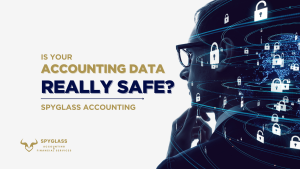
Is Your Accounting Data Really Safe?
The Overlooked Gaps in Cybersecurity That Could Cost You a Fortune
In today’s digital-first world, accounting firms are a prime target for cybercriminals. With sensitive financial data, client information, and transaction details at stake, the stakes have never been higher. But here’s the critical question: Is your accounting data really safe? Despite the best efforts of IT teams and accountants, there are often overlooked gaps in cybersecurity that could leave your firm vulnerable to devastating breaches. Let’s explore the risks, the consequences, and the best practices to protect your data—before it costs you a fortune.
The Growing Threat to Accounting Data
Accounting firms are a goldmine for hackers. According to a report cited by Accounting Seed, one in three accounting firms experiences a cyberattack, making the industry the fifth most targeted sector. Why? Because financial data is incredibly valuable. From bank account numbers and credit card details to social security numbers and transaction histories, a single breach can expose a treasure trove of sensitive information.
But it’s not just external threats you need to worry about. Insider threats—whether intentional or accidental—are equally dangerous. A single employee error, like clicking on a phishing link or misconfiguring a network, can lead to catastrophic consequences. 95% of data breaches are caused by human error. That’s a staggering statistic that should make every accountant and business owner pause.
The Cost of a Data Breach: More Than Just Money
The financial impact of a data breach is undeniable. The average cost of a data breach in 2023 was $4.45 million, a 15% increase over three years. But the damage doesn’t stop there. A breach can tarnish your firm’s reputation, erode client trust, and even lead to legal penalties for non-compliance with data privacy regulations like GDPR or CCPA.
Take the example of Capital One’s 2019 data breach, where an employee illegally accessed an Amazon Web Server, exposing 100 million credit card applications and 140,000 social security numbers. The fallout was immense, both financially and reputationally. And it’s not just large firms at risk—small businesses are often targeted too, with 60% failing within six months of a cyberattack.
The Overlooked Gaps in Accounting Cybersecurity
So, where are the gaps in your cybersecurity strategy? Here are some often-missed vulnerabilities:
- Outdated Software: Failing to update software leaves your systems exposed to known vulnerabilities. Content Snare reports that 80% of data breaches could have been prevented with timely updates.
- Weak Access Controls: Not all employees need access to sensitive financial data. Without role-based access controls, you’re inviting unnecessary risk.
- Lack of Employee Training: Phishing and social engineering attacks prey on human error. Regular training can help employees recognize and avoid these threats.
- Insufficient Encryption: Data encryption is non-negotiable. Without it, even a minor breach can expose your entire financial database.
- No Real-Time Monitoring: Without tools to monitor and audit access to financial data, suspicious activities can go unnoticed until it’s too late.
Best Practices to Secure Your Accounting Data
The good news? You don’t have to be a cybersecurity expert to protect your firm. Here are some actionable steps to close those gaps and safeguard your data:
- Implement Multi-Factor Authentication (MFA): MFA adds an extra layer of security, ensuring that even if passwords are compromised, unauthorized users can’t access your systems.
- Encrypt Everything: Encrypt data both in transit and at rest. This ensures that even if hackers intercept your data, they can’t read it.
- Conduct Regular Privacy Audits: As suggested by a report, integrating privacy audits into your financial assessments can help identify vulnerabilities before they’re exploited.
- Train Your Team: Regular cybersecurity training can reduce the risk of human error. Teach employees to recognize phishing attempts and follow secure data practices.
- Backup Your Data: Regular backups ensure that you can recover quickly in the event of a breach or system failure.
- Invest in Secure Accounting Software: Choose platforms with built-in security features like user permissions, real-time monitoring, and audit trail functionality.
Key Takeaways
- Accounting firms are a top target for cyberattacks, with one in three experiencing a breach.
- Human error is the leading cause of data breaches, accounting for 95% of incidents
- The average cost of a data breach is $4.45 million, but the reputational damage can be even more devastating.
- Overlooked gaps like outdated software, weak access controls, and insufficient encryption can leave your firm vulnerable.
- Best practices include MFA, encryption, regular training, and investing in secure accounting software.
Final Thoughts
The question isn’t if your accounting data is at risk—it’s when. By addressing the overlooked gaps in your cybersecurity strategy, you can protect your firm from financial losses, reputational damage, and regulatory penalties. Don’t wait until it’s too late. Start implementing these best practices today or contact Spyglass Accounting expert, and give yourself the peace of mind that comes with knowing your data is truly secure.
Your data is your most valuable asset—protect it like your business depends on it. Because it does.

